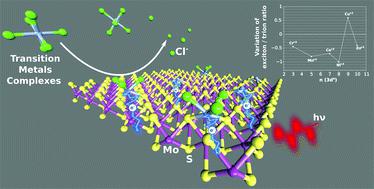Our official English website, www.x-mol.net, welcomes your feedback! (Note: you will need to create a separate account there.)
3d transition metal coordination on monolayer MoS2: a facile doping method to functionalize surfaces
Nanoscale ( IF 6.7 ) Pub Date : 2022-06-10 , DOI: 10.1039/d2nr01132h He Liu 1 , Walner Costa Silva 2 , Leonardo Santana Gonçalves de Souza 2 , Amanda Garcez Veiga 2 , Leandro Seixas 3, 4 , Kazunori Fujisawa 5, 6, 7 , Ethan Kahn 8 , Tianyi Zhang 8 , Fu Zhang 8 , Zhuohang Yu 8 , Katherine Thompson 1 , Yu Lei 8 , Christiano J S de Matos 3, 4 , Maria Luiza M Rocco 2 , Mauricio Terrones 1, 6, 7, 8 , Daniel Grasseschi 2
Nanoscale ( IF 6.7 ) Pub Date : 2022-06-10 , DOI: 10.1039/d2nr01132h He Liu 1 , Walner Costa Silva 2 , Leonardo Santana Gonçalves de Souza 2 , Amanda Garcez Veiga 2 , Leandro Seixas 3, 4 , Kazunori Fujisawa 5, 6, 7 , Ethan Kahn 8 , Tianyi Zhang 8 , Fu Zhang 8 , Zhuohang Yu 8 , Katherine Thompson 1 , Yu Lei 8 , Christiano J S de Matos 3, 4 , Maria Luiza M Rocco 2 , Mauricio Terrones 1, 6, 7, 8 , Daniel Grasseschi 2
Affiliation

|
Two-dimensional materials (2DM) have attracted much interest due to their distinct optical, electronic, and catalytic properties. These properties can be tuned by a range of methods including substitutional doping and, as recently demonstrated, by surface functionalization with single atoms, thus increasing the 2DM portfolio. We theoretically and experimentally describe the coordination reaction between MoS2 monolayers and 3d transition metals (TMs), exploring their nature and MoS2–TM interactions. Density functional theory calculations, X-ray photoelectron spectroscopy (XPS), and photoluminescence (PL) spectroscopy point to the formation of MoS2–TM coordination complexes, where the adsorption energy for 3d TMs resembles the crystal-field (CF) stabilization energy for weak-field complexes. Pearson's theory for hard–soft acid–base and ligand-field theory were used to discuss the periodic trends of 3d TM coordination on MoS2 monolayer surfaces. We found that softer acids with higher ligand field stabilization energy, such as Ni2+, tend to form bonds with more covalent character with MoS2, which can be considered a soft base. On the other hand, harder acids, such as Cr3+, tend to form more ionic bonds. Additionally, we studied the trends in charge transfer and doping observed from XPS and PL results, where metals like Ni led to n-type doping. In contrast, Cu functionalization results in p-type doping. Therefore, the formation of coordination complexes on TMD's surface is a potentially effective way to control and understand the nature of single-atom functionalization of TMD monolayers without relying on or creating new defects.
中文翻译:

单层 MoS2 上的 3d 过渡金属配位:一种表面功能化的简便掺杂方法
二维材料(2DM)由于其独特的光学、电子和催化特性而引起了极大的兴趣。这些特性可以通过一系列方法进行调整,包括替代掺杂,如最近所证明的,通过单原子的表面功能化,从而增加 2DM 产品组合。我们从理论上和实验上描述了 MoS 2单层和 3d 过渡金属 (TM)之间的配位反应,探索了它们的性质和 MoS 2 -TM 相互作用。密度泛函理论计算、X 射线光电子能谱 (XPS) 和光致发光 (PL) 光谱表明 MoS 2的形成-TM 配位配合物,其中 3d TM 的吸附能类似于弱场配合物的晶体场 (CF) 稳定能。Pearson 的硬-软酸-碱理论和配体场理论用于讨论MoS 2单层表面上3d TM 配位的周期性趋势。我们发现具有较高配体场稳定能的较软酸,例如Ni 2+,倾向于与MoS 2形成具有更多共价特征的键,这可以被认为是软碱。另一方面,较硬的酸,如 Cr 3+,倾向于形成更多的离子键。此外,我们研究了从 XPS 和 PL 结果中观察到的电荷转移和掺杂趋势,其中 Ni 等金属导致了 n 型掺杂。相反,Cu 功能化导致 p 型掺杂。因此,在 TMD 表面形成配位配合物是控制和理解 TMD 单层单原子功能化性质的潜在有效方法,而无需依赖或产生新的缺陷。
更新日期:2022-06-10
中文翻译:

单层 MoS2 上的 3d 过渡金属配位:一种表面功能化的简便掺杂方法
二维材料(2DM)由于其独特的光学、电子和催化特性而引起了极大的兴趣。这些特性可以通过一系列方法进行调整,包括替代掺杂,如最近所证明的,通过单原子的表面功能化,从而增加 2DM 产品组合。我们从理论上和实验上描述了 MoS 2单层和 3d 过渡金属 (TM)之间的配位反应,探索了它们的性质和 MoS 2 -TM 相互作用。密度泛函理论计算、X 射线光电子能谱 (XPS) 和光致发光 (PL) 光谱表明 MoS 2的形成-TM 配位配合物,其中 3d TM 的吸附能类似于弱场配合物的晶体场 (CF) 稳定能。Pearson 的硬-软酸-碱理论和配体场理论用于讨论MoS 2单层表面上3d TM 配位的周期性趋势。我们发现具有较高配体场稳定能的较软酸,例如Ni 2+,倾向于与MoS 2形成具有更多共价特征的键,这可以被认为是软碱。另一方面,较硬的酸,如 Cr 3+,倾向于形成更多的离子键。此外,我们研究了从 XPS 和 PL 结果中观察到的电荷转移和掺杂趋势,其中 Ni 等金属导致了 n 型掺杂。相反,Cu 功能化导致 p 型掺杂。因此,在 TMD 表面形成配位配合物是控制和理解 TMD 单层单原子功能化性质的潜在有效方法,而无需依赖或产生新的缺陷。



























 京公网安备 11010802027423号
京公网安备 11010802027423号